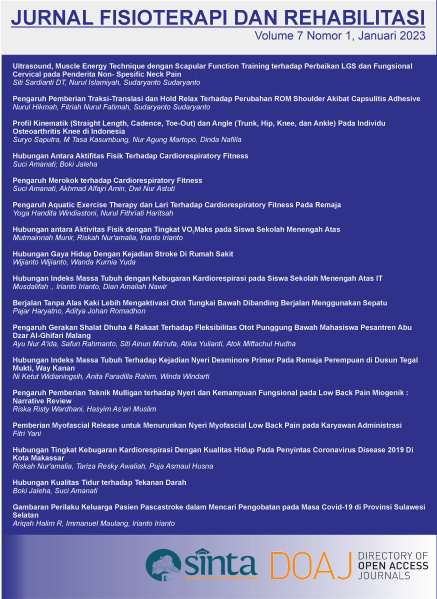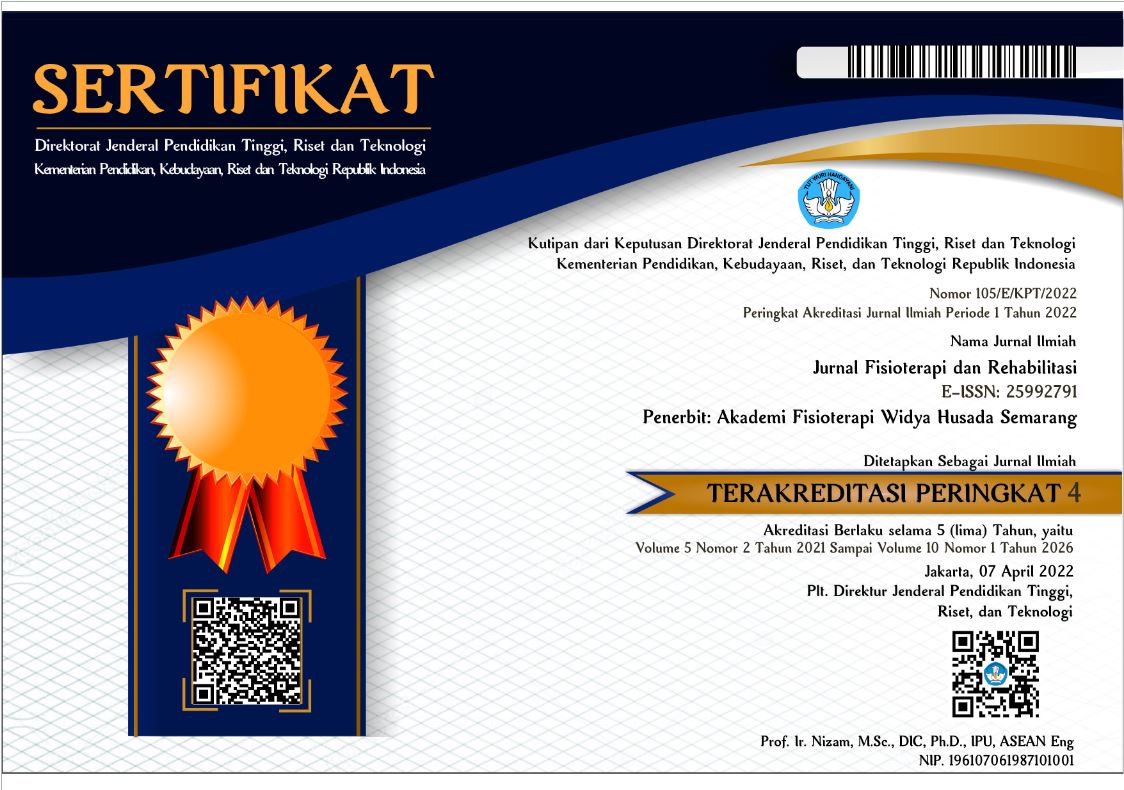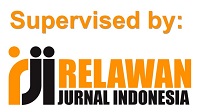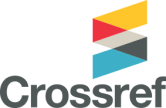Ultrasound, Muscle Energy Technique dengan Scapular Function Training terhadap Perbaikan LGS dan Fungsional Cervical pada Penderita Non- Spesific Neck Pain
Ultrasound, Muscle Energy Technique with Scapular Function Training to Repair ROM and Cervical Function in Non-Specific Neck Pain
Abstract
Latar Belakang : Non-spesific neck pain merupakan nyeri leher mekanik yang umumnya disebabkan karena adanya faktor kebiasaan postur yang jelek meliputi kebiasaan bekerja dalam posisi yang tidak ergonomis secara berulang-ulang sehingga menyebabkan peregangan pada ligament dan otot secara berlebihan, dan memperlihatkan keterbatasan gerak lateral fleksi dan rotasi cervical. Metode : Penelitian ini adalah penelitian ekspirimen dengan desain randomized pre test – post test control group design, dilaksanakan di Klinik Mabbulosibatang Fisioterapi dengan sampel sebanyak 26 orang mahasiswa Hasil : Berdasarkan analisis uji paired sample t pada kelompok perlakuan dan kontrol diperolehan nilai p=0,000 (p<0,050) untuk semua kelompok data, yang berarti bahwa kombinasi US, Muscle Energy Technique dan Scapular Function Training dan kombinasi US, Muscle Energy Technique dapat memberikan perbaikan LGS lateral fleksi dan rotasi cervical serta disabilitas cervical yang signifikan. Hasil uji independent sampel t diperoleh nilai p=0,926 (lateral fleksi), p=0,269 (rotasi), dan p=0,501 yang berarti bahwa tidak ada perbedaan yang signifikan antara kedua kelompok. Kesimpulan : Disimpulkan bahwa kombinasi Ultrasound, Muscle Energy Technique dan Scapular Fungction Training tidak lebih efektif daripada kombinasi Ultrasound dan Muscle Energy Technique terhadap perbaikan LGS dan fungsional cervical pada non-spesific neck pain.
Downloads
References
Apoorva, P., Nilima, B., Ashok, S., Parag, S. 2016. Effect of muscle energy technique and static stretching on pain and functional disability in patients with mechanical neck pain. Journal Hong Kong Physiotherapy: Vol 35: 5-11.
Arovah, N. 2010. Dasar-dasar fisioterapi pada cedera olahraga. Yogyakarta.
Cesar, F., Joshua, A., Peter A. 2011. Neck and arm pain sydromes. Cihina: Elsevier.
Chaitaw, L. 2013. Muscl Energy Technique. Fourth Edition. China: Elsevier
Christoffer, H., Andersen, Lars, L., Mette, K., Zebis, Gisela, S. 2014. Effect of Scapular Function Training on Chronic Pain in the Neck/Shoulder Region. Journal Occuo Rehabil: Vol 24: 316-324.
Cook, C.E. 2011. Orthopedic Manual Therapy An Evidence-Based Approach. Second Edition. New Jersey: Pearson Prentice Hall.
Elfindri, Hasnita, E., Abidin, Z., Machmud, E. 2012. Metodologi penelitian kesehatan. Jakarta: Baduose Media Jakarta.
Francis, H., Dino, S., Richard, G. 2015. Cervical Spine. China: Elsevier Saunders.
James, R., Dunning, Joshua, A., Mark, A., Waldrop, Cathy, A., Ian, Y., Michael, T., Gisli, S. 2012. Upper Cervical and Upper Thoracic Thrust Manipulation Versus Nonthrust Mobilization in Patients With Mechanical Neck Pain. Journal of orthopaedic & sports physical therapy: Vol 42: Number 1.
James, W., Susan, L., Thomas, P. 2016. Modalitas fot Therapeutic Intervention. Sixth Edition. United States of America: Contemporary Perspectives in Rhabilitation.
Keith, L., Arthur, F., Anne, M., Marion, M. 2013. Anatomi Berorientasi Kinis. Edisi ke Lima. Jilid 2. Jakarta : Erlangga.
Keith, L., Arthur, F., Anne, M. 2018. Clinically Oriented Anatomy. Eighth Edition. China: Wolters Kluwer.
Megan, L., Heintz., Eric J., Hegedus. 2018. Multimodal Management of Mechanical Neck Pain Using a Treatment Based Classification System. The Journal Of Manual & Manipulative Therapy. Vol 16: Number 4.
Michlovitz, S., James, B., Thomas, N. 2012. Modalitas for therauputic intervention. Fifth edition. Philadelphia: F.A. Davis Company. Minna, S. 2014. Non-Specific Neck Pain In Preadolescent To Adolescent Populations.
Helsinki: Unigrafa.
Muhammad, A. 2015. Hubungan antara Beban Tas Punggung dengan Non-Spesific Neck Pain pada Mahasiswa. Thesis. UIN Syarif Hidayatullah Jakarta.
Nancy, B., William, D. 2017. Joint Range of Motion and Muscle Length Testing. Third Edition. Elsevier Health Sciences.
Phil, P., Clare, P., Robert, L. 2010. Assessment and Treatment of Muscle Imbalance. United States of America: Human Kinetics
Pier, P. 2016. Cervical Spine. New York Dordrecht London: Springer International Publishing Switzerland.
Richa, K., Amir, I., Ahmad, H. 2018. Controlled intervention to compare the efficacies of manual pressure release and the muscle energy
technique for treating mechanical neck pain due to upper trapezius trigger points. Journal of Pain Research. Volume 11: Number 3151-3160.
Robin, M. 2014. Seven Step to A Pain-Free Life. United states Amerika Serikat: Penguin Group LLC.
Saavedra, Manuel, H., Castro, Adelaida, S., Arroyo, M., Manuael, Cleland, A., Joshua, Lara, P., Inmaculada, Fernadez, Cesar. 2012. Short-Term Effect of Kinesio Tapping Versus Cervical Thrust Manipulation in Patiens With Mechanical Neck Pain. A Randomized Clinical Trial.
Seyda, T., Turkan A., Derya, O. 2016. A Comparison of the Eff ects of Stabilization Exercises Plus Manual Therapy to Those of Stabilization Exercises Alone in Patients With Nonspecifc Mechanical Neck Pain. Journal of orthopaedic & sports physical therapy: Vol 46: Number 2

This work is licensed under a Creative Commons Attribution 4.0 International License.
The use of the article will be governed by the Creative Commons Attribution license as currently displayed on Creative Commons Attribution 4.0 International License.
Author’s Warranties
The author warrants that the article is original, written by stated author(s), has not been published before, contains no unlawful statements, does not infringe the rights of others, is subject to copyright that is vested exclusively in the author and free of any third party rights, and that any necessary written permissions to quote from other sources have been obtained by the author(s).
User Rights
JFR's spirit is to disseminate articles published are as free as possible. Under the Creative Commons license, JFR permits users to copy, distribute, display, and perform the work. Users will also need to attribute authors and JFR on distributing works in the journal.
Rights of Authors
Authors retain all their rights to the published works, such as (but not limited to) the following rights;
- Copyright and other proprietary rights relating to the article, such as patent rights,
- The right to use the substance of the article in own future works, including lectures and books,
- The right to reproduce the article for own purposes,
- The right to self-archive the article
Co-Authorship
If the article was jointly prepared by other authors, any authors submitting the manuscript warrants that he/she has been authorized by all co-authors to be agreed on this copyright and license notice (agreement) on their behalf, and agrees to inform his/her co-authors of the terms of this policy. JFR will not be held liable for anything that may arise due to the author(s) internal dispute. JFR will only communicate with the corresponding author.
Miscellaneous
JFR will publish the article (or have it published) in the journal if the article’s editorial process is successfully completed. JFR's editors may modify the article to a style of punctuation, spelling, capitalization, referencing and usage that deems appropriate. The author acknowledges that the article may be published so that it will be publicly accessible and such access will be free of charge for the readers as mentioned in point 3.












